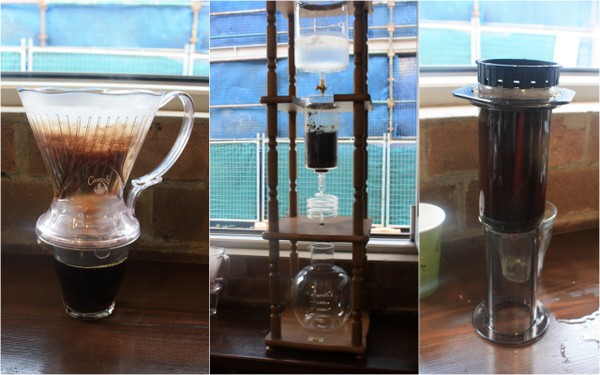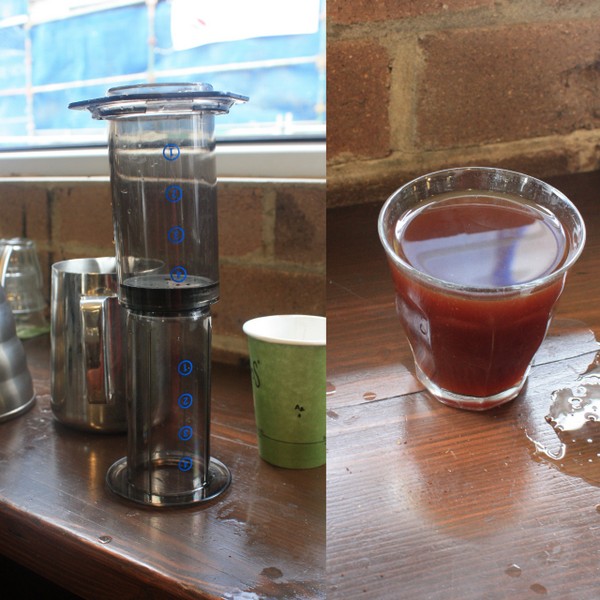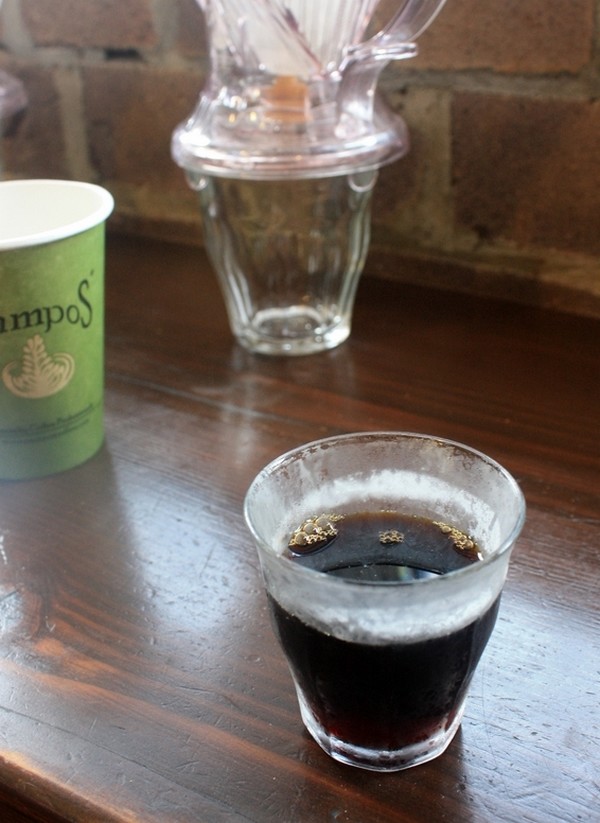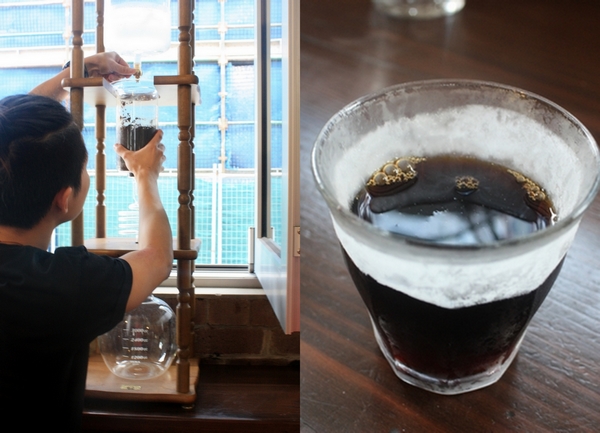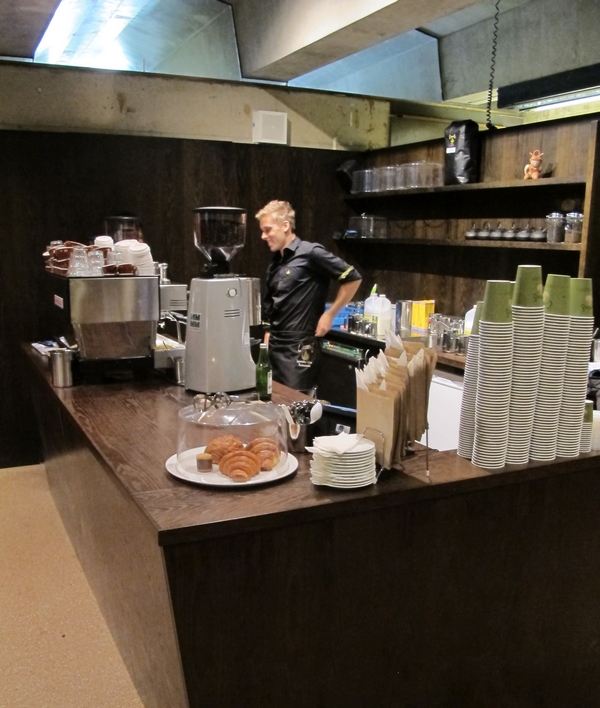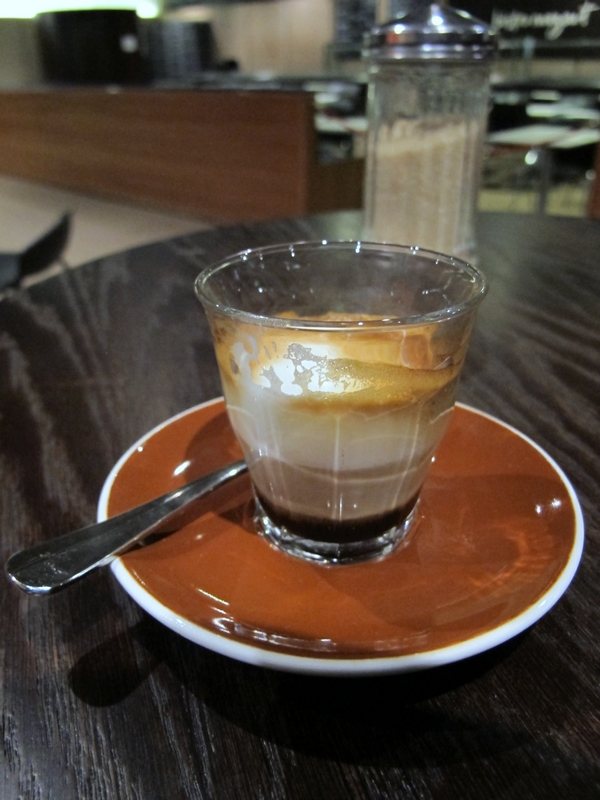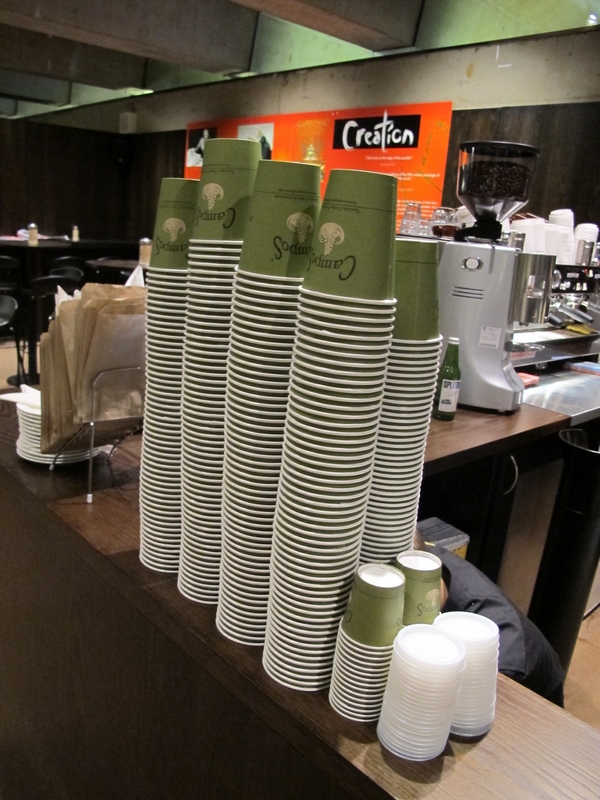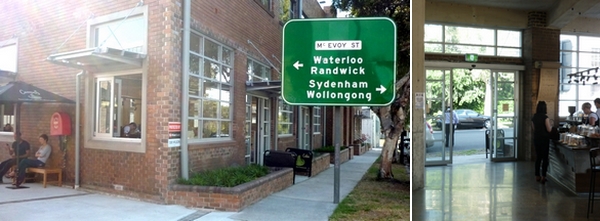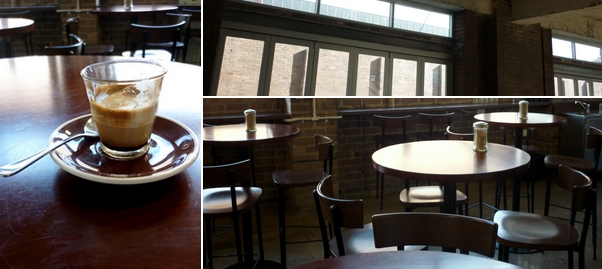Manual brewing, alternative brewing, whatever you want to call it, it’s time to give it a go. DIY brewing methods such as aeropress, cold brew, pourover, syphon and their more well-known cousins such as French press and stove top coffee form another frontier in the exploration of coffee flavour. What’s more, they’re portable, cheap and easy to learn.
embedded by Embedded Video
YouTube
Still not convinced? Then check out my Q&A with Campos’ resident black coffee fanatic David Ruslie above. He talks black coffee culture in Australia, who’s ahead in the Sydney vs. Melbourne black coffee game and why you should give a damn about hands-on coffee brewing.
Other Black Coffee Revolution Posts:
Aeropress
Cold Drip Coffee
In these posts, we look at black coffee – the contraptions, the methods, the how to’s and the why’s. David Ruslie, Campos’ resident black coffee obsessive, walks us through aeropress, cold drip and pourover. He says there’s a growing interest in black coffee, because, sans milk and sugar, it really allows you to explore the flavour profiles of the coffees themselves.
“Coffee appreciation…it’s catching up to wine appreciation. There’s a lot more tasting notes, say with wine you have 200 tasting notes. Well, with coffee, you have 800 tasting notes, it’s really incredible.” David says. Sure, the man or woman on the street doesn’t need to know all 800 to enjoy their ‘new brew’, but it’s handy, he says, to be able to identify which flavours you prefer. You may think you’re not a black coffee drinker, but maybe you just haven’t found the right bean or the right method.
This week David shows us the simplest and most portable of the black coffee methods, aeropress. There are two main ways David uses the aeropress: the ‘normal’ method and the inverted method. In both cases, he advises that you pre-wet the paper filter with a few drops of water beforehand. To be precise, it’s also worth having a digital scale on hand to weigh your coffee and water, but you can also do it by sight. And the reason the water is boiled at the very beginning is that we’re aiming for water temperature of 92-96 degrees. The video gives you a good idea of what the below instructions actually look like in practice. If you’re interested in buying an aeropress, follow this link.
What you need:
– An aeropress
– an aeropress paper filter
– a kettle
– a mug to drink out of
– ground coffee or coffee beans
– a hand grinder (optional)
– a digital scale (optional)
embedded by Embedded Video
YouTube
The Normal Method
1. Boil your kettle.
2. Dampen the paper filter, place it in the aeropress disc and fit the disc into the larger of the two tubes.
3. Place the aeropress, filter end down on your scales and ‘zero’ them. Grind and/or pour in coffee to the desired weight.
4. Place aeropress over a mug or jug, filter side down.
5. Zero your scales again. Pour in 200g of boiled water. Give it a stir. Steep for 45 seconds.
6. Stir once again and place the ‘plunger’ in the aeropress. Slowly push down until all coffee is in the cup (about 20 seconds).
The Inversion/Upside Down Method
1. Boil your kettle.
2. Push the ‘plunger’ into the aeropress tube and turn upside down so that the tube is on top and the plunger is on the bottom.
3. Place it on your digital scales and ‘zero’ them. Grind and/or pour in coffee to the desired weight into the tube.
4. Zero your scales again. Pour in 200g of boiled water. Do not stir. Dampen the paper filter, place it in the aeropress disc and place on top of the upside down aeropress. Steep for 1 minute and 30 seconds.
5. Stir the coffee to break the crust. Fit the disc into the top of the aeropress. Place a jug or mug upside down on it.
6. Flip the entire aeropress 100 degrees. Slowly push down until all coffee is in the cup or jug (about 20 seconds).
Other Black Coffee Revolution Posts:
Cold Drip Coffee
Over the next month, I look at black coffee – the contraptions, the methods, the how to’s and the why’s. David Ruslie, Campos’ resident black coffee obsessive, walks us through aeropress, cold drip and pourover and explains why he’s so passionate about this back-to-basics approach.
“Australian coffee culture is actually milk coffee culture, and I’m trying to change it,” David tells me. Single-handedly trying to convert us from flat-whites-with-one to siphon/cold drip/aeropress? Not so much, Dave says, but he’s excited to share the precision and hands-on nature of black coffee brewing with me. He kindly offered to walk me through these ‘third wave’ or ‘fourth wave’ (whatever it is we’re up to now) methods. We’re going to start with the chemistry lab setup that is cold drip.
David explains that there are two basic methods of coffee making- immersion and percolation, and cold drip is full percolation. This method involves steeping fresh, coarse coffee grounds at room temperature over time, usually around 12 hours. This results in an extremely caffeinated, low acidity, sweet-tasting cold coffee, and a brew that non-espresso drinkers often warm to. ‘It doesn’t actually taste like coffee.’ says David, which is a good way of explaining the flavour- bright, mild and tea-like.
For the cold drip, David used 1500mls of water for 250g of ground coffee, with a resulting yield of 1200ml of cold drip brew. The ideal brewing time is 12-15 hours, as there is no heat to aid extraction. David favours 8-9 drips per 10 seconds
As complex as this chemistry lab setup may look, you don’t necessarily need it to cold brew your own coffee at home. Similar results can be achieved by steeping coffee in a jar or overnight, and then pouring the resulting liquid through a coffee filter and chilling for future use. You can also do this in a French press, as you would for hot coffee but again, overnight.
embedded by Embedded Video
YouTube
The video above demonstrates how cold drip is made. For more info on how to brew you own cold coffee at home, click here.
Are you a cold coffee fan? What’s your fave way to enjoy it?
Other Black Coffee Revolution Posts:
Aeropress
“To find our newest Campos Coffee espresso bar, head to the Sydney Opera House, go to the top of the stairs, and at the box office, and turn left.” So the Campos crew wrote a few days ago, and by gum I was there to check it out.
When I arrive around 4:30pm in their soft opening week, there’s not a customer in sight, but I can see they’ve been busy that day. I order my macch, take a seat and its there in a flash. It’s a true Campos macch, creamy and frothy the way I like it, and I linger over it in the mostly empty cafe.
The space is small and cave-like, but there’s not much you can do about the concrete interior of this part of the iconic Sydney landmark. Campos branding is scarce, which I find interesting; I was expecting the solid wood furniture and smattering of coffee paraphernalia of their sister stores. No matter, I enjoy my ‘Roy’s special’ as the boys call it and they let me happily snap away as they talk cafe processes and procedures in hushed tones. I think it was working in coffee shops that made me realise the extent of my process-driven pedantry.
For a brand of such success, Campos has opened precious few stores in its short lifetime; by my count this will be their fifth store. But these guys have always understood that the key to coffee is consistency: quality control = branding.
Putting a store in the Sydney Opera House makes sense from every possible angle, its too perfect. The new store started trading on September 5th from 10:00am – 6:00pm, but from next Monday (September 10th) they will be trading 8:00am to 6:00pm, 7 days a week.
Campos Coffee Sydney Opera House
Sydney Opera House (near the box office)
Bennelong Point
Sydney, NSW 2000
If you follow the cyclists, you’ll find a good cafe. Turns out those fixies mounted on the wall in your local trendy coffee house aren’t always just for decoration. I challenge you to find somewhere in this wide brown land more cycle friendly than our Nation’s Capital. Canberra has almost as many bike paths as there are roads and so it stands to reason there has to be more than one place to find a good macch. And so early one Canberra morning we rose with the cyclists and followed them to Farmer’s Daughter.
Farmer’s Daughter is at the Yarralumla shops, an old and well-off suburb 5 minutes west of Parliament house. Yeah, like that’s how Canberrans give directions. Anyway, It’s just after 9:00am when we arrive, so we have our pick of tables. By 9:45 the place is pretty much full and the wait is long for those who want a 10:00 or 11:00 am breakky.
The menus are on cute little clipboards and it’s one of those occasions where everything sounds enticing; enough adjectives to intrigue but not so many as to overwhelm. I consider the french toast, described as ‘soft toasted brioche slices served with fresh summer berries and lavender cream’, but I can never quite go past a savoury brunch and so I choose the fried egg bruschetta with romesco. Breakfast dishes hover around the $16 mark, so you know if it’s less than perfect I’ll be sending it back.
The coffee menu is why we’re really here, as farmer’s Daughter serve cold drip and syphon as well as espresso. What I like about their specialty coffee menu is that it’s all written down as part of the normal menu, not on a blackboard or just as something you have to know to ask for. I like that they’ve described what each method involves and tastes like on their menu, leaving you to order the drink, ask questions about it, or not. I know most people drink espresso but I’m sure many are curious to have a go at siphon or cold drip or pourover, but aren’t quite sure where to begin. All too often specialty, back-to-basics coffee can be quite intimidating for the unnanitiated coffee drinker, but not so at Farmer’s Daughter, so assuming that hipster coffee places actually *want* a bigger uptake of these alternacoffees, this is a smart move.
Between the four of us we order a macchiatto (guess who?), a picollo latte, a siphon coffee and a fire and ice espresso shot, which is two shots of a single origin espresso, one in a frozen glass and one in a room temperature glass. This is to show of the differing flavours at different temperatures, as is the Siphon, which you drink cup by cup from hot to lukewarm to appreciate its subtle, tea-like flavour, but also how that flavour changes as the temperature drops. It’s actually quite fun try both of these coffee methods, and there’s nothing patronising or pretentious about the way they’ve each been presented.
The fried egg bruschetta is great, with runny yolks and firm-enough whites, although the romesco has the quality of those cashew and capsicum deli dips – it tastes store bought, although I can’t say for sure. Who cares, it’s delish. The other dishes on our table are equally tasty, from the poached eggs with ‘finishing touches’ to the the ‘no ordinary soldiers’, three toasts with a different topping for each: smoked salmon and crème fraîche on one, parmesan and rocket on another and the third with prosciutto and romesco.
Overall I’d say I enjoyed breakfast at Farmer’s Daughter, I even went back for a second macch (naughty), this time a single origin, the Rwanda Maraba III Sovu Cup of Excellence which is indeed both velvety and fusgy as the Campos website decrees. I will return, bright and early, to sip a syphon and investigate their menu further.
Farmer’s Daughter
27B Bentham St, Yarralumla
Yarralumla, ACT 2600
02 6281 2233
Monday- Saturday 7:00am – 3:00pm
While it might be a common occurrence for other food bloggers, it’s not usual for me to receive invitations to, well, anything. So when the folks at Campos asked me if I’d like to come check out The Cupping Room above their flagship store in Newtown, it’d be an understatement to say I was excited, especially since it had been on my to-do list since forever.
When I arrive at 5 to 3 on a Saturday, it’s hot and crowded and I can’t move for the customers. I’m not surprised, it’s one of the reasons I don’t come here that often, but when my partner in crime arrives, she’s shocked. ‘It’s as if there aren’t any other coffee shops in Newtown,’ she marvels. Well, for some, that may be true. We elect to wait outside. 10 or so minutes later we’re led through the crowd to the back of the store, up the steep stairs lit by a single dangling light bulb. Like an old-time speakeasy, a panel in the door slides open and a pair of eyes peer out. ‘Two?’ Asks a voice. We nod. We enter.
The space is pitch black save for a long wooden table, stainless-steel edged and lit by a line of spotlights. Our host, Todd has laid out 6 small bowls of coarsely ground coffee for each of us to ‘cup’ or taste. Cupping, he explains, is standard practice for roasters all over the world. The idea of cupping is that because you’re removing all the variables inherent in brewing coffee, you’re leveling the playing field and you really are just tasting the coffee. Each step of the cupping is usually given a score and that’s how a coffee is chosen by buyers.
Latte glasses of water and metal spoon glint in the light as Todd explains the process. The first step, he says, is smelling each grind. We inhale each cup (well, not literally, but you know what I mean) and leave the descriptions to the expert. Next, Todd lets the coffee steep in 93° water for 7 to 15 minutes. We then break the ‘crust’ of grounds that has formed on the top, careful to expose rather than destroy the crema. Once we’ve ‘crusted’ each cup we are to taste each one in turn without speaking – this is the time to form our initial impression. Each coffee must be taken with a single, sharp sip from our spoon. Todd makes a loud definitive ‘slurp’ with his, practically inhaling the brew but we’re more timid.
Afterwards we take our time though the 6 grinds, which have been set up in a very deliberate order, and we discuss the flavour profiles of each one. Todd says there’s no wrong answer here and encourages us to describe the coffees. I find this very difficult to do, but as soon as he mentions a flavour, for example ‘citrus’ or ‘earthy’, I find his description fits what I’m tasting, and it’s more than just the power of suggestion.
The coffees we taste are:
Indonesian Toarco Jaya – a solid, well rounded base.
The Ethiopian Lekempti – fruity, lemony. Yum!
Panama Emporium – I’m not sure how to explain this, but I don’t like it. It reminds me of that nauseous feeling of having had 5 or 6 coffees.
Colombian el tiestro –I liked it but I don’t remember much else about it.
Kenya Gethumbbwini – Very strong and zesty, like lemon peel.
Supermarket coffee – tastes like nothing.
Campos cups a variety of beans every day in their warehouse to maintain the consistency of their signature blend, ‘Superior’. They will roast on a Monday, cup in a Tuesday and adjust the ratios accordingly on a Wednesday, and this cycle continues each day. Visiting coffee plantations and tasting their crops has been recreated in a much more pristine and theatrical setting here at the cupping room. I ask what coffee producers would think of their gleaming setup and he admits they’d probably find it pretty bizarre.
The Cupping Room
193 Missenden Road,
Newtown NSW 2042
(02) 9690 0294
Sessions Tuesday to Friday at 7:30 and 2.00pm
Saturday’s at 8:30am, 1:00pm and 3:00pm
Campos’ second Sydney store is nothing special from the outside. Blink and you’ll miss it, as the old saying goes. And in fact, I did- for three whole months. It was only when I came out of Dan Murphy’s a couple of weeks ago that I noticed a café across the road, and headed over to check it out. ‘I think it’s a real Campos,’ I marvelled to my boyfriend, meaning it’s not just some café that stocks Campos but it is actually a coffee bar they own and run. We had to give it a try.
Even though I’m quite capable of making my own coffee, I’ve got to admit my heart skipped a beat at the thought a of a solid, reliable coffee shop walking distance from my house, maybe with somewhere nice to sit rather than our slowly deteriorating, floods-when-it-rains, overpriced terrace. On entering the store I was not disappointed. Polished concrete floors, exposed brick, high ceilings, industrial fittings, floor to ceiling windows – can I move in here?
You’ll find Don Campos at ‘The Fountain’, a newly gutted and refurbished warehouse on Fountain Street, Alexandria that’s been subdivided into yet-to-be-leased retail space. Right now Campos is the only tenant on the ground floor so there’s an eerie sense of space. You can take a seat at one of their trademark annoyingly high stools or sit outside surrounded by industrial bleakness but don’t worry, this area is well on its way to full gentrification á la Danks Street.
As with Campos’ Newtown store, you order and pay at the counter and the staff bring the coffee to your table. Food is self serve at the time of ordering and there’s a filtered water tap embedded in a window-side bench if you need your thirst quenched. The menu is minimalist- miniature sandwiches and jewel-like cakes encrust the front counter. We got our coffees quickly, although there was a bit of a wait between them, which I always find a tad odd, especially as we ordered a macchiato and a piccolo latte.
The emphasis here is well and truly on the coffee, which is as it should be. There are various blends and single origins to try, as well as Campos’ sparkling long black which I’ve yet to sample. Don Campos claims to be Sydney’s first Siphon Bar, siphon coffee being a coffee geek’s dream fusion of coffee and chemistry which is super trendy these days. So don your hipster specs and have a go. Or let these guys do it for you.
The verdict? Delicious. These guys made my dream macchiato, a drink which is known for being slightly different everywhere. I like mine with a decent amount of foam and a dash of milk. I’ve visited Don Campos three times in two weeks and all of my coffees have been a sight to behold, swirls of smooth, perfectly textured milk and a crema-rich coffee shot. The first time I went I had their dark City blend, which was fantastically rich and dark without being bitter. The other times I’ve been I had what I assume was their Superior Blend, which I sometimes buy pre-ground for home use. I found that less impressive, lacking the punch I was after.
There is admittedly a lot of hype around Campos as a brand and, as with all hype, take it with a grain of salt. I will say that they choose which cafés they supply very carefully, in accordance with their ‘charter’, and I can also honestly say I have never had a bad Campos Coffee. However, that doesn’t mean every single coffee I’ve had from them has been fantastic. In the case of Don Campos, you can always send it back if it’s not.
Don Campos
Shop 2, 21 Fountain Street,
Alexandria NSW 2015
(02) 9690 0090
Weekdays: 6:30am – 3:30pm
Weekends: 8:00am – 4:30pm
About me
 Sharing easy recipes, hunting down the best coffee. Honest accounts, nothing too serious. Read more...
Sharing easy recipes, hunting down the best coffee. Honest accounts, nothing too serious. Read more...Recent Posts
- Aerpress means no more shit #travelcoffee and #workcoffee
- Why I write and four ace bloggers who do it better
- The five best things I ate in London
- Shoreditch is awesome, airports are not
- I quit sugar? Do I bollocks.
- Cubao Street Food, Alexandria
- The Reformatory Caffeine Lab, Surry Hills
- Brewtown Newtown
- Stay caffeinated over Christmas
- Gumption by Coffee Alchemy, Sydney CBD
Popular posts this month…
 Sparkling Long Black posted on May 10, 2011
Sparkling Long Black posted on May 10, 2011  Review – Philips Saeco Intelia posted on January 10, 2012
Review – Philips Saeco Intelia posted on January 10, 2012  Kosher Whole Orange Cake posted on July 5, 2011
Kosher Whole Orange Cake posted on July 5, 2011  Cheat’s Dulce de Leche posted on January 7, 2011
Cheat’s Dulce de Leche posted on January 7, 2011  The quest for Mex part 2 – Feisty Chicken Burritos posted on December 21, 2010
The quest for Mex part 2 – Feisty Chicken Burritos posted on December 21, 2010  Café Review – Petty Cash Cafe, Marrickville posted on May 31, 2011
Café Review – Petty Cash Cafe, Marrickville posted on May 31, 2011  Salat Hatzilim posted on January 28, 2011
Salat Hatzilim posted on January 28, 2011 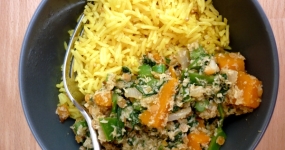 Sri Lankan Spinach with Coconut posted on December 10, 2010
Sri Lankan Spinach with Coconut posted on December 10, 2010
Disclaimer:
All opinions in this blog are mine, an everyday, real-life person. I do not accept payment for reviews and nor do I write sponsored posts. I do not endorse the content of the comments herein.

